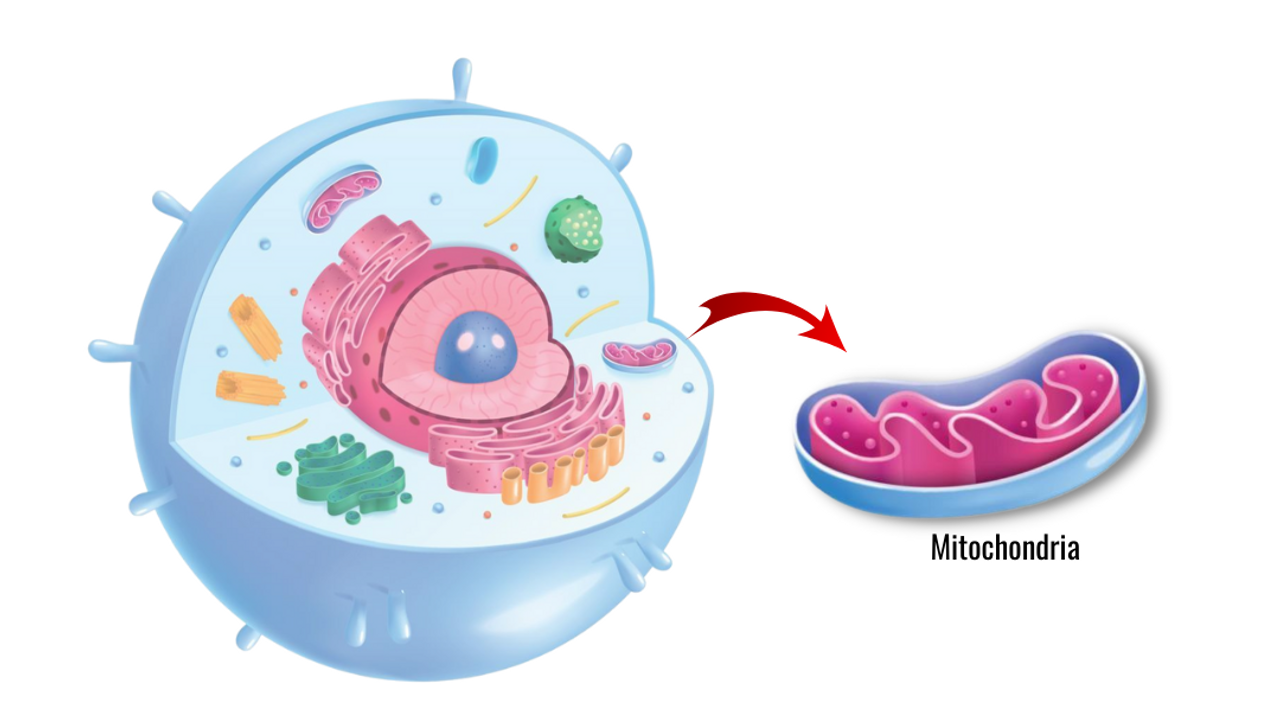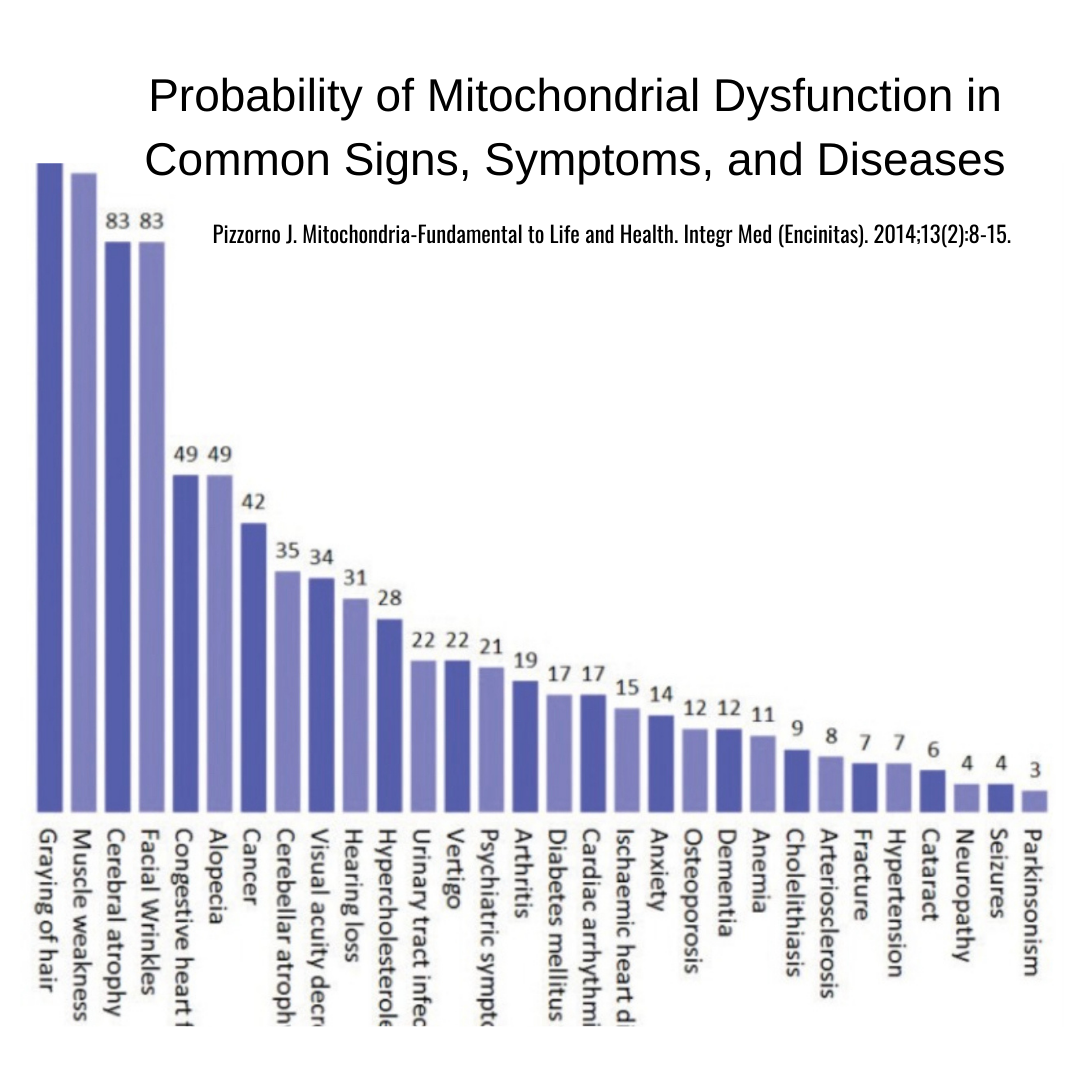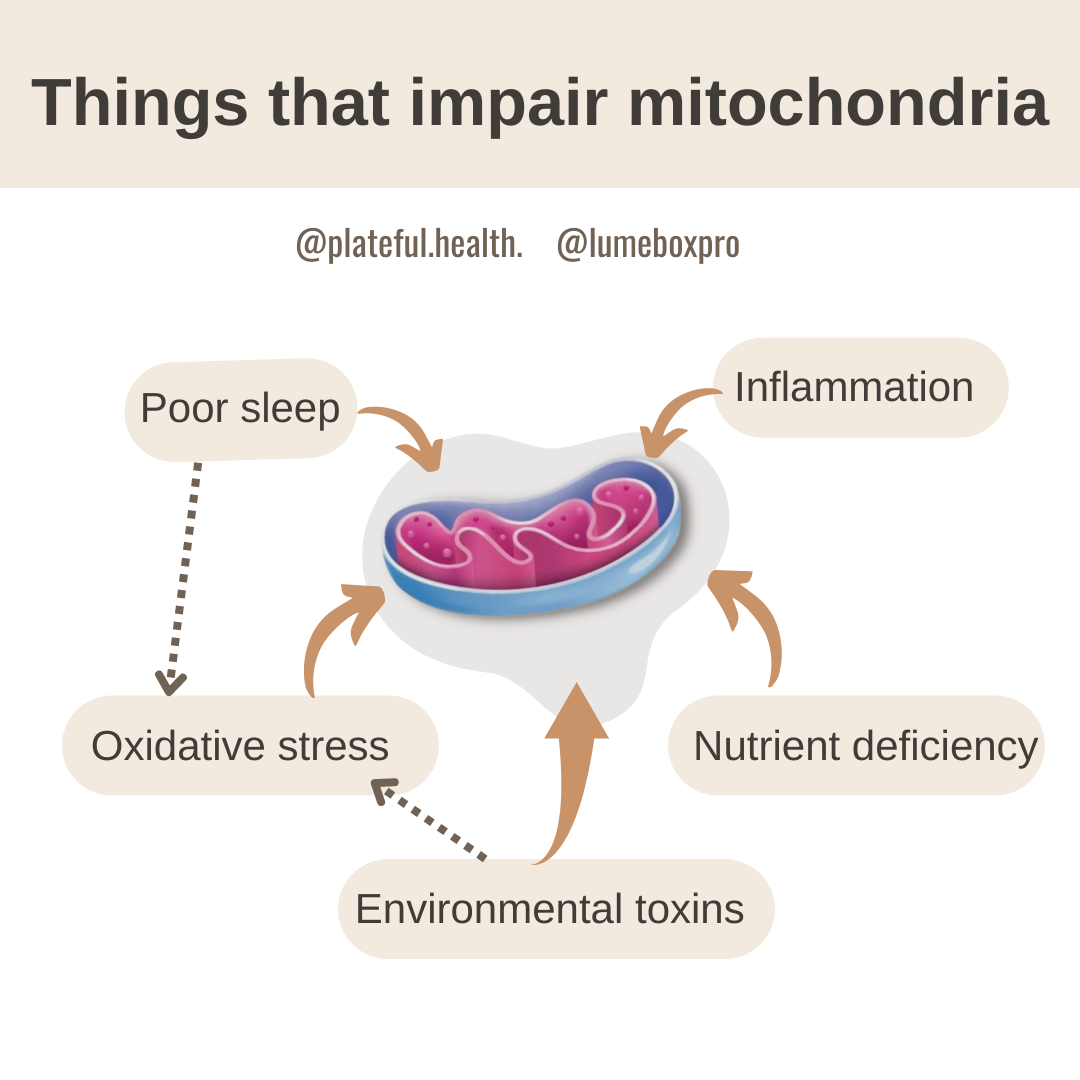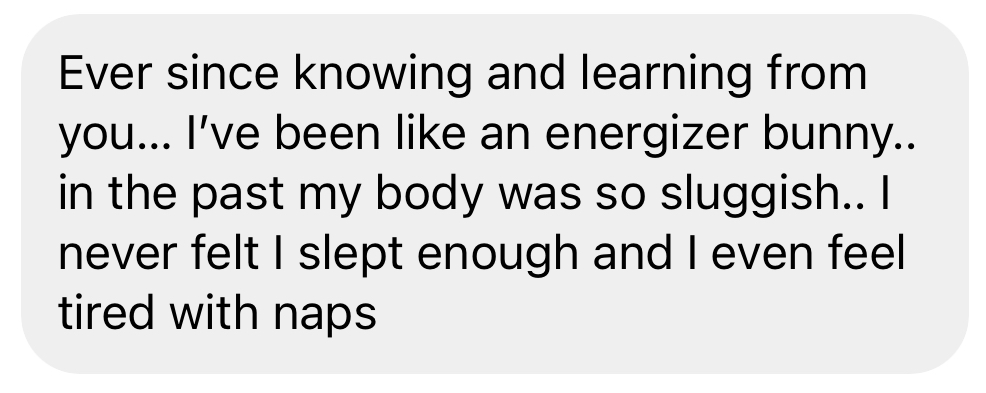Want to slow aging and have more energy?

At medical school, I learned about mitochondrial DISEASES - manifestations of usually genetically related conditions like Leigh Syndrome, which are extremely rare and easier to diagnose because the symptoms are severe.
What I did NOT learn was the vast spectrum of mitochondrial DYSFUNCTION most people are walking around with, flying under the radar because the symptoms are vague and there are no reliable labs for diagnosing it - tiredness, brain fog, declining memory, hormone dysregulation (like thyroid or diabetes), premature aging, and so much more....
Our mitochondria are ESSENTIAL for us to have energy and thrive.
After we've eaten our food, it is down to the mitochondria to turn the nutrients into useable energy for our cells.
So think of them as the chargers for your cells.
What happens to your phone if you don't charge your phone at the end of the day?
It dies and you cannot make calls or text anymore.
The same thing happens to our cells.
Without adequate energy, the cell cannot do what it's meant to do:
- In the skin, it's making collagen
- In the brain, it's helping us think, remember, and regulate our mood
- In the liver, it's helping us detoxify, make bile
- In the muscle, it's walking, running, athletic performance
- In the ovary and testes, it's producing hormones, eggs, and sperms (this is why so many of the supplements often recommended 'for fertility' are actually mitochondrial supporting nutrients like CoQ10, NAC - fertility is energy-dependent!
In the scientific literature, mitochondrial dysfunction has been associated with numerous conditions [1]:
- Early aging
- Amyotrophic lateral sclerosis
- Alzheimer’s disease
- Autism
- Cardiovascular disease
- Chronic fatigue syndrome
- Dementia
- Diabetes
- Huntington’s disease
- Migraine headache
- Parkinson’s disease
And here's a chart I took from a paper by Dr. Joseph Pizzorno on mitochondrial dysfunction.

I can go on but I think you get the gist.
Suffice it to say, if you want to stay healthy with the passage of time, looking after your mitochondria should be a priority.
Sadly, most people are walking around in the modern world with suboptimally functioning mitochondria, because these little structures are very sensitive to environmental damage.
Their nemesis is free radicals, which are damaging compounds our bodies naturally produce through metabolic processes or obtained from our environment.
This is why eating fruits and veggies is so good for us - they are full of antioxidants that mop up these free radicals, thus protecting our cells.
Things that commonly damage our mitochondria are:
- Environmental toxins: things like heavy metals and pesticides can damage our mitochondria directly and also cause free radicals in our bodies which then also damage our mitochondria
- Medications (certain antibiotics and acetaminophen, and statins - note, I am NOT saying you should shop your meds - they can be life-saving and very necessary, so discuss this with your doctor)
- Poor sleep
- Alcohol
- Stress

As you can see, these things are ubiquitous in modern life - and let's be real, who ISN'T stressed?
We also cannot avoid environmental toxins 100% - they are everywhere - so let's flip the script and move from Debbie Downer to how we can empower ourselves to power our cells (pun intended!)
Ways to Support your Mitochondria:
1. Good nutrition - focus on eating a balanced diet rich in plants, which are full of antioxidants and feed our gut microbiome. Did you know that the gut microbiome also has an impact on our mitochondria too? And don't worry, I am not asking you to eat rabbit food; tea, coffee, herbs, and spices are antioxidant-rich and delicious ways to add these beneficial compounds into your diet - my favorites are matcha and blueberries.
Unless you have food allergies, try to incorporate different nuts/seeds/legumes/whole grains and beans, and healthy fats from whole food sources like avocado into your diet.
Lots of my clients come to me on 10+ supplements 'for their mitochondria' when their diet hasn't been optimized yet. Supplements are expensive, can be contaminated with toxins, and most don't contain what they say they contain. My goal with my clients is to get them OFF their laundry list of supplements and still feel great. In fact, a client just texted me this, it made my day:

Start with food first, and IF you still need a supplement, by all means, discuss this with your doctor and choose a high-quality one.
Nutrients that are important are:
- B vitamins (the whole family, not just B12)
- Magnesium
- Omega 3 fatty acids
- Carnitine (don't fret vegan friends, our bodies can make carnitine from amino acids lycine and methionine, abundant in whole grains and beans)
- Antioxidants (including vitamin C, E)
- Some supplements that may be useful (but always discuss with your doctor) if you are deficient: CoQ10, alpha-lipoic acid, and N-acetyl-Cysteine.
2. Reduce your intake of refined sugar and processed foods - these cause oxidative stress in our bodies.
3. Optimize sleep and reduce stress
Easier said than done, I know... but sleep is when our tissues and mitochondria can repair
4. Exercise - especially strength training which builds muscle bulk and provides oxygen for our mitochondria to work.
5. Breathe properly - Oxygen is an essential nutrient for mitochondrial health, and most of us are not breathing correctly for maximum oxygen intake, especially if we have desk jobs. Take 1-2 minutes every hour to take deep belly breaths, I do a lot of breathwork, and I really like the work of Wim Hoff and Schott Schwenk.
5. Light - Last, but not least, something that most of us are not getting enough of, since we spend 90% of our time indoors in the US according to the EPA.... safe light exposure! Light is vital for life, and it's not just there to help us see, our cells actually have receptors for it! There is no denying that UV rays can damage and burn our skin, so it is important to practice safe sun exposure and avoid getting burnt.
Talking about light is like using the term 'animals' to describe a labrador - there is a huge spectrum of different wavelengths of light, and they all have different impacts on our bodies. Sunlight is full-spectrum i.e. it encompasses all the wavelengths like blue, green, red, and it is the UV component of sunlight that can cause burning and skin damage.
However, red light is devoid of the damaging potential of UV and has been extensively studied for health
I can't always get sun exposure, so I utilize RED LIGHT THERAPY, which is safe because it is devoid of UV rays.
What is red light therapy?
If you just searched 'photobiomodulation' on pubmed, you'll see 2000+ articles on it. Photobiomodulation is a fancy name for red light therapy, another term commonly used is LLLT (low level laser therapy)
It is basically the utilization of specific wavelengths of light to activate and 'wake up' our mitochondria.
You can read more here but in essence, our mitochondria have receivers for red light and can absorb it.
When red light is absorbed by the mitochondria, it activates many processes:

In simple terms, these processes provide more energy for the cell, increase blood flow and lower inflammation which leads to healthier cells that can perform better.
This is why red light therapy has been associated with many benefits, the most studied being:
- Skin rejuvenation - This is the reason I first started using red light therapy a few years ago. I had read several studies [2], [3] showing RLT can support collagen production and reduce collagen breakdown. We know that the skin starts to lose collagen in our 20s, so I decided to try it when I turned 40. It took a little time to see the effects, but after 5-6 weeks, I saw a marked improvement in my skin tone, less acne, more radiance, more plumpness and I don't have any permanent wrinkles yet. Since then, I've also read studies showing it can help with acne, and my daughter loves using it to prevent/help with her teenage acne (side note, blue light has also been shown to be beneficial for acne).
- Pain - several mechanisms underlie how red light therapy may be helping some people with pain: reducing tissue inflammation, altering pain signals from nerve fibers, reducing swelling, muscle spasm and aiding tissue repair. [4, 5]. My dad was nearly bedbound with piriformis syndrome 3 years ago. He was misdiagnosed with sciatica, and given tons of anti-epileptic medications, pain killers which made him constipated and worsened his pain. Nothing worked for 3 weeks, so I flew home to the UK and lent him my RLT device. After a week, he was back on his feet, and after 4 weeks of consistent use, he was better. I became a firm believer thereafter.
- Muscle recovery and injuries [6], [7] - RLT always comes to the rescue when I overtrain and have sore muscles, it also helped my husband SO MUCH when he tore his calf muscle 5 weeks ago. He needed NO painkillers and was back on his feet without a boot after 3 weeks and is now walking normally.
- Wound healing [8] my kids are always coming home with cuts and scrapes - and RLT comes in super handy to help those wounds heal.
There are also studies showing potential in supporting cognitive function, and mood, more research is needed as these studies are smaller and preliminary.
RLT has benefitted me and my family so much I decided to partner with the company Lumebox to spec my own superior device. If you want in on the super low presell price I negotiated for my audience, sign up here to get first dibs on our 1st Birthday SALE May 3-7th!
I prefer a handheld device to the larger panels for convenience, it allows me to use it while relaxing on the sofa, in the car, or in bed.
However, most handheld units on the market are underpowered and too small for my liking.
I wanted a unit that can cover my whole face and decolletage/thyroid area, and I wanted a unit that was powerful enough to deliver meaningful irradiance from a distance away, without me having to hold it for a long time to receive the beneficial dose.
So I spec'd Lumebox:
- Lab-tested to be 80% more powerful than leading brand
- Has more bulbs so covers 25% more surface area
- Has a longer battery life, shorter charging time
- Low EMF
- 3rd party tested for safety: meets IEC 60601-1, 60601-11, 62471 and meets Good Manufacturing Practices (GMP) under ISO 13485.
- Every batch 3rd party is inspected by SGS.
- Registered with the FDA.
Get LUMEBOX at 40% off HERE
References:
[1] Pizzorno J. Mitochondria-Fundamental to Life and Health. Integr Med (Encinitas). 2014;13(2):8-15.
[2] Jagdeo J, Austin E, Mamalis A, Wong C, Ho D, Siegel DM. Light-emitting diodes in dermatology: A systematic review of randomized controlled trials. Lasers Surg Med. 2018 Jan 22;50(6):613–28. doi: 10.1002/lsm.22791. Epub ahead of print. PMID: 29356026; PMCID: PMC6099480.
[3] Avci P, Gupta A, Sadasivam M, Vecchio D, Pam Z, Pam N, Hamblin MR. Low-level laser (light) therapy (LLLT) in skin: stimulating, healing, restoring. Semin Cutan Med Surg. 2013 Mar;32(1):41-52. PMID: 24049929; PMCID: PMC4126803.
[4] Dima R, Tieppo Francio V, Towery C, Davani S. Review of Literature on Low-level Laser Therapy Benefits for Nonpharmacological Pain Control in Chronic Pain and Osteoarthritis. Altern Ther Health Med. 2018 Sep;24(5):8-10. PMID: 28987080.
[5] Cotler HB, Chow RT, Hamblin MR, Carroll J. The Use of Low Level Laser Therapy (LLLT) For Musculoskeletal Pain. MOJ Orthop Rheumatol. 2015;2(5):00068. doi:10.15406/mojor.2015.02.00068
[6] Wang W, Jiang W, Tang C, Zhang X, Xiang J. Clinical efficacy of low-level laser therapy in plantar fasciitis: A systematic review and meta-analysis. Medicine (Baltimore). 2019;98(3):e14088. doi:10.1097/MD.0000000000014088
[7] Ferraresi C, Hamblin MR, Parizotto NA. Low-level laser (light) therapy (LLLT) on muscle tissue: performance, fatigue and repair benefited by the power of light. Photonics Lasers Med. 2012 Nov 1;1(4):267-286. doi: 10.1515/plm-2012-0032. PMID: 23626925; PMCID: PMC3635110.
[8] Hopkins JT, McLoda TA, Seegmiller JG, David Baxter G. Low-Level Laser Therapy Facilitates Superficial Wound Healing in Humans: A Triple-Blind, Sham-Controlled Study. J Athl Train. 2004;39(3):223-229.
[9] de la Torre JC. Treating cognitive impairment with transcranial low level laser therapy. J Photochem Photobiol B. 2017 Mar;168:149-155. doi: 10.1016/j.jphotobiol.2017.02.008. Epub 2017 Feb 13. PMID: 28219828.

